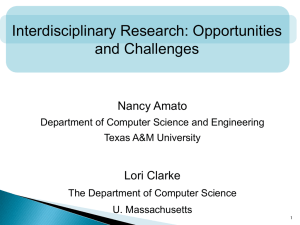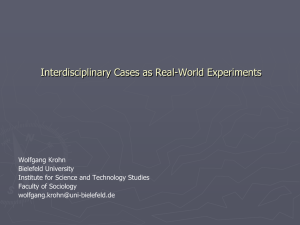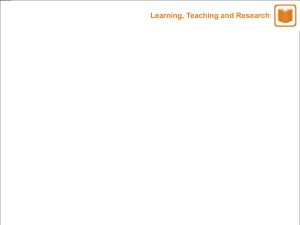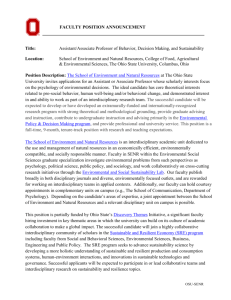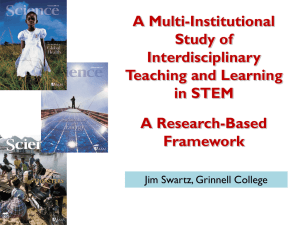Finding Interdisciplinary Common Ground for
advertisement
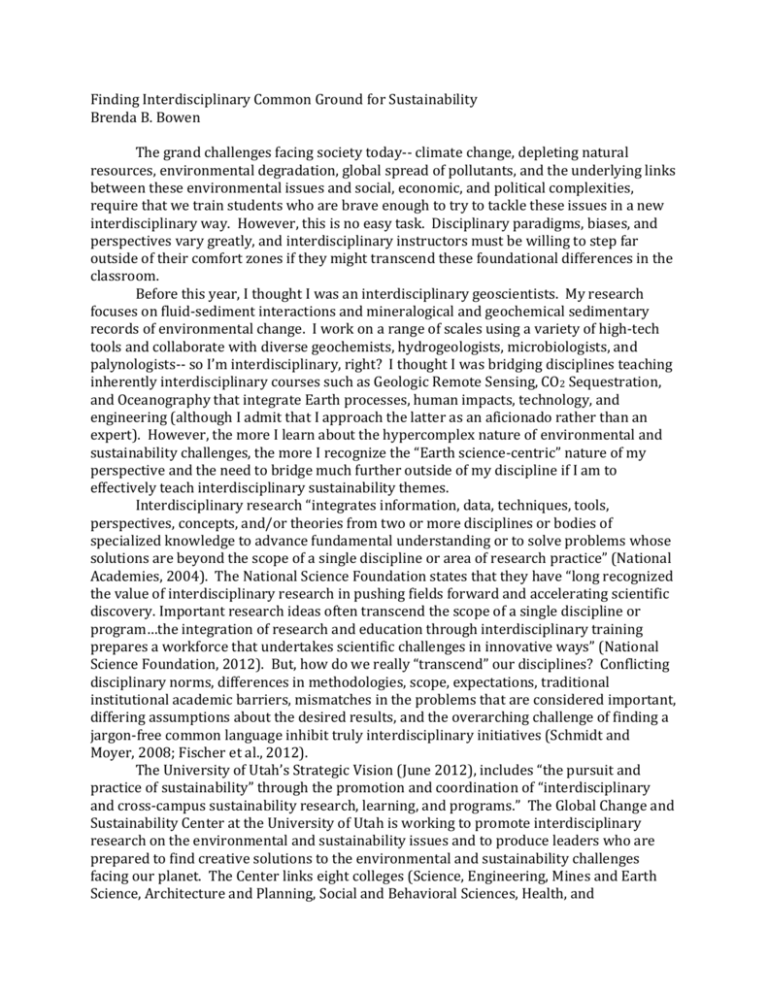
Finding Interdisciplinary Common Ground for Sustainability Brenda B. Bowen The grand challenges facing society today-- climate change, depleting natural resources, environmental degradation, global spread of pollutants, and the underlying links between these environmental issues and social, economic, and political complexities, require that we train students who are brave enough to try to tackle these issues in a new interdisciplinary way. However, this is no easy task. Disciplinary paradigms, biases, and perspectives vary greatly, and interdisciplinary instructors must be willing to step far outside of their comfort zones if they might transcend these foundational differences in the classroom. Before this year, I thought I was an interdisciplinary geoscientists. My research focuses on fluid-sediment interactions and mineralogical and geochemical sedimentary records of environmental change. I work on a range of scales using a variety of high-tech tools and collaborate with diverse geochemists, hydrogeologists, microbiologists, and palynologists-- so I’m interdisciplinary, right? I thought I was bridging disciplines teaching inherently interdisciplinary courses such as Geologic Remote Sensing, CO2 Sequestration, and Oceanography that integrate Earth processes, human impacts, technology, and engineering (although I admit that I approach the latter as an aficionado rather than an expert). However, the more I learn about the hypercomplex nature of environmental and sustainability challenges, the more I recognize the “Earth science-centric” nature of my perspective and the need to bridge much further outside of my discipline if I am to effectively teach interdisciplinary sustainability themes. Interdisciplinary research “integrates information, data, techniques, tools, perspectives, concepts, and/or theories from two or more disciplines or bodies of specialized knowledge to advance fundamental understanding or to solve problems whose solutions are beyond the scope of a single discipline or area of research practice” (National Academies, 2004). The National Science Foundation states that they have “long recognized the value of interdisciplinary research in pushing fields forward and accelerating scientific discovery. Important research ideas often transcend the scope of a single discipline or program…the integration of research and education through interdisciplinary training prepares a workforce that undertakes scientific challenges in innovative ways” (National Science Foundation, 2012). But, how do we really “transcend” our disciplines? Conflicting disciplinary norms, differences in methodologies, scope, expectations, traditional institutional academic barriers, mismatches in the problems that are considered important, differing assumptions about the desired results, and the overarching challenge of finding a jargon-free common language inhibit truly interdisciplinary initiatives (Schmidt and Moyer, 2008; Fischer et al., 2012). The University of Utah’s Strategic Vision (June 2012), includes “the pursuit and practice of sustainability” through the promotion and coordination of “interdisciplinary and cross-campus sustainability research, learning, and programs.” The Global Change and Sustainability Center at the University of Utah is working to promote interdisciplinary research on the environmental and sustainability issues and to produce leaders who are prepared to find creative solutions to the environmental and sustainability challenges facing our planet. The Center links eight colleges (Science, Engineering, Mines and Earth Science, Architecture and Planning, Social and Behavioral Sciences, Health, and Humanities) and over 15 departments, and thus I start to realize my previously limited notion of interdisciplinarity. One of my primary duties as Associate Director of this Center is to teach interdisciplinary sustainability-focused courses such as “Global Changes and Society.” This is a graduate level project-based course that includes students from many disciplines including geology and geophysics, atmospheric science, mathematics, biology, civil and environmental engineering, mechanical engineering, geography, and city and metropolitan planning. The course aims to help the students learn to speak a common language to practically address sustainability questions, each bringing their own expertise to bear as they explore the connection between Earth systems and human systems and work to find real world solutions to wicked problems. There is widespread recognition of the importance of interdisciplinary education for sustainability, and sustainability curriculum programs are growing. The Council of Environmental Deans and Directors of the National Council for Science and the Environment found that since 2008 the number of interdisciplinary environmental and sustainability degree programs among four-year colleges and universities in the U.S. increased by 57% -- and the number of schools hosting such programs increased by 29% (Vincent et al. 2012). These trends also reflect the growing job opportunities in sustainability and the “green economy.” Bureau of Labor Statistics data indicate that green industries are growing faster than the overall economy and U.S. states that have stronger green economies have fared better during the economic recession (Pollack 2012). As a geoscientist, I recognize the need for students who will work on complex environmental issues to understand fundamental Earth systems-- the physical, chemical, and biological processes that govern rates of change over magnitudes of scale. Practitioners of sustainability must also understand possibilities for engineered solutions, for creatively applying science and technology. But is that enough? So many scientists and engineers, even those working on critical topics that clearly have implications for resource management and policy, stop shy of stepping out of their seemingly objective world of science and engineering. STEM students are not trained to bridge from the scientific method to value judgments, and thus miss opportunities to communicate the significance of their work to policy makers and the public. I strive to work at this fringe-- pushing Earth scientists into a realm of interdisciplinary awareness and guiding them towards a recognition of the need for creative communication to bridge into the realm of policy, decision making, and public perception to promote sustainability. Rather than simply bringing researchers in different fields together, we need to cultivate a new kind of scientist who will be able to more easily bridge interdisciplinary divides (Schmidt and Moyer, 2008). A recent discussion on these challenges in Science (Pfirman, 2012) gave the following recommendations for interdisciplinary scholars: Prepare yourself for new ways of working, thinking, and interacting. Specialize within your interdisciplinary research area. Avoid the tendency to branch out too quickly and in too many directions, which can diffuse your impact. Focus on your disciplinary strength and skills. It may sound counterintuitive, but in many situations your value as an interdisciplinary colleague is directly proportional to your skills in your own discipline. Keep up with the latest literature and theoretical developments in your disciplinary field so that you will be prepared to apply new knowledge and skills in diverse areas. Build core competencies that sustain interdisciplinary research by taking courses or learning on your own. For example, you could take courses that use the case study method to enhance interdisciplinary skills or include practice reviewing interdisciplinary papers and proposals. Attend seminars and workshops in other disciplines. Participating in research seminars outside your own department is a great way to expand your thinking, add a new batch of colleagues to your network, and develop expertise in new research areas. Seek new mentorship. The old model of one scholar, one mentor is fast becoming a distant memory. Find a mentor or two from beyond your field to help broaden your mindset and approaches.



